Earlier this week, Casio officially unveiled their all new smart outdoor watch, the Pro Trek Smart WSD-F20. This is their second GPS watch aimed squarely at the outdoor market, following last year’s announcement with a relatively similar model.
This year though the plan is to ship following release of Android Wear 2.0 on April 21st with a retail price of $500. Casio has taken a slightly different approach to the GPS watch, forgoing things like an optical heart rate sensor in favor of focusing more directly on outdoor sports. There is quite a bit to cover here so let’s jump right in.
The Watch itself
The watch itself will ship with two color variants, orange and black. The Pro Trek Smart is equipped with a touch screen and three physical buttons (Power, App, and Tool). All three of the buttons are located on the right side of the device while the left side is reserved for the charging port and a spot for the device’s barometric altimeter. In terms of overall design I’d have to say it leaves a bit to be desired. It looks authentically Casio with the outwardly blocky design, but I’m not sure that is a good thing in a GPS smartwatch where you are already going to be adding bulk due to battery and other components.
As noted above, Casio decided to leave out an optical heart rate sensor. In talking with the company at length, it sounded as though they felt that optical HR data isn’t accurate and therefore users aren’t actually using it.
Obviously, I’m not sure I totally agree with this (and the market also seems to overwhelmingly disagree), but at least you still have the option to add a Bluetooth Smart heart rate sensor thanks to Android Wear. Speaking of Android Wear, the Pro Trek Smart will ship with AW 2.0, and the company did confirm that their previous Android Wear watch, the WSD-F10, should receive the upgrade to 2.0 this Spring. However, it’s important to note that the timelines for Android Wear itself aren’t finalized, so hanging their hat on an April release date may be risky if Android Wear continues its release date slide. Still, many other companies are also making that same bet – so at least they’re all in the same boat.
Outside of the functionality that Casio is shipping with the watch, Android Wear provides things like interactive notifications (meaning you can take direct action from the watch – like replying to a text message), Google Assistant, and all of the 3rd party apps that are being written and released for Android Wear 2.0.
That’s a pretty big list, and of course is a major selling point for aligning to the Android Wear platform. You’re talking apps like Strava, MapMyFitness, and many more. All of which can help fill gaps in the platform as it stands out of the box.
Dual Layer Display
One of the more interesting hardware components of the Pro Trek Smart is the inclusion of a dual layer display, something that was also found in its predecessor. This component allows the watch to essentially have two modes:
A) Smartwatch mode
B) Monochrome mode
The watch has a dual layer LCD, allowing it to have a full-color LCD screen for things like maps, notifications, and activities; as well as having a monochrome LCD with extremely low power draw. The watch can be configured to switch the displays as necessary, allowing the monochrome to be visible whenever color isn’t necessary.
This hybrid mode allows for the Pro Trek Smart to function like a normal watch with low power draw when not in smartwatch mode. Speaking of battery life, Casio was a bit careful with battery claims. They say that battery validation is ongoing and they hope to have exact figures soon but users can expect similar battery life to the WSD-F10 (roughly 1 day in typical smart watch mode and up to 30 days in monochrome mode).
Maps
Casio has made a point to include offline maps in the Pro Trek Smart. With the inclusion of a bright color LCD touchscreen and the ability to load color map data for offline viewing, Casio is positioning the Pro Trek Smart as a watch for those who enjoy the great outdoors. They are leveraging Mapbox to provide offline maps for a given area allowing the user to be completely disconnected from cellular service while retaining navigational abilities thanks to GPS.
Maps can be downloaded from Mapbox in advance and loaded onto the watch. If you are looking to take a break from technology and go hiking through the woods but also want to be able to find your way home, the Pro Trek Smart has your back.
Pro Trek Apps
In addition to the growing ecosystem of Android Wear, Casio has chosen to include a handful of first party applications – Activity, Location Memory, Moment Setter, TOOL and Moment Link. Each of these was written by Casio and build off the showcase activities that Casio is supporting (Trekking, Fishing, Cycling, Snow, and Paddle Sports). The apps will capture data relevant to the event (Activity), allow you to create waypoints based on an event (Memory), provide relevant information to a given activity based on time, location or even preferred fishing conditions (Moment Setter), display environmental and other user data (TOOL), and allow you to share these experiences with friends (Moment Link).
All of the watches available were in demo mode and so the full functionality of these apps wasn’t on display. For a device that isn’t expected to ship for three months, that’s understandable but unfortunate. My only real impression was that there didn’t seem to be much synergy between the Android Wear 2.0 design and the Casio custom design. I feel that the true value of the app ecosystem is going to be from the Google Play store and not from the inbox applications.
Thankfully the activity tracker portion of the watch is a native Android Wear feature so it looks right at home and appears to work as expected.
Video Overview:
Updated: Hey folks (Ray here), I went out and shot a video overview of the unit Saturday evening. They were being a bit more flexible with units then, as well as some spec details.
As you can see, the unit was still in demo mode, so it’s highly limited in what you can see, but figured folks would enjoy nonetheless.
Summary
When I showed up to the Casio press event the day before CES I wanted to like their watch. Ray had seen it posted around the convention center on their sponsored materials ahead of its announce and it was clear they were going to make a splash with the Pro Trek Smart.
After sitting through the press event they had several watches on display for photographs, but you weren’t allowed to touch them or change the screens. If you’ve been reading Ray for long enough you know that is a bad sign. Thankfully, they had plenty of units in the booth set up and open to the public.
I’m not entirely sure the difference a day makes, but alas, I was thankful to get hands-on with them today. After a few minutes of walking through it myself I spoke with some of the booth staff who were very helpful.
Unfortunately, there just isn’t much you can do if the product doesn’t fit the market. While I could be woefully misjudging the Pro Trek Smart, I doubt it. Ray has had the chance to speak with a number of different people about the product (industry analysts, other media, sports tech companies) and the general consensus is confusion as to who Casio is planning to sell this watch to. At $500, they aren’t likely to get the casual GPS purchaser. That is a significant amount of money and the customer is more likely to do their part to be well informed and possibly even get hands-on. When you stack this watch up against the rest of the market (Garmin’s Fenix5, Suunto’s Spartan Ultra, and Polar’s M600), the Pro Trek Smart just isn’t competitive. Heck, you could compare it against products from a year prior and reach the same conclusion.
Though oddly – the overarching comment of everyone Ray and I discussed it with was the same: Their baby is ugly. And unfortunately, in the wearables world – having an ugly baby is a tough hurdle to overcome. And at this point in time the combination of clunky design, a crappy charger and a $500 price point don’t add up to a best seller.
—
With that – thanks for reading!
Don’t forget to check out all the CES 2017 coverage, as well as continual updates throughout the day on Twitter. It’s gonna be a crazy busy week!
FOUND THIS POST USEFUL? SUPPORT THE SITE!
Hopefully, you found this post useful. The website is really a labor of love, so please consider becoming a DC RAINMAKER Supporter. This gets you an ad-free experience, and access to our (mostly) bi-monthly behind-the-scenes video series of “Shed Talkin’”.
Support DCRainMaker - Shop on Amazon
Otherwise, perhaps consider using the below link if shopping on Amazon. As an Amazon Associate, I earn from qualifying purchases. It doesn’t cost you anything extra, but your purchases help support this website a lot. It could simply be buying toilet paper, or this pizza oven we use and love.

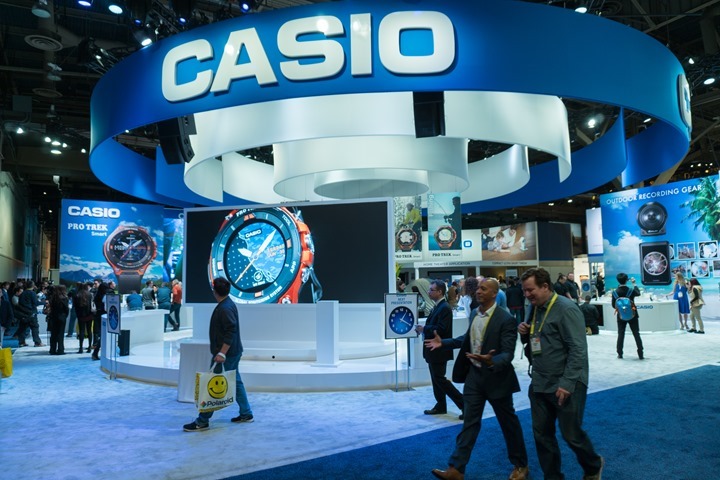
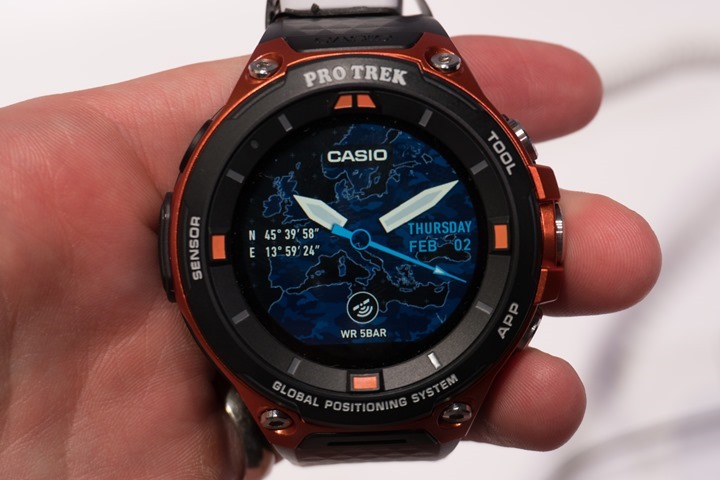
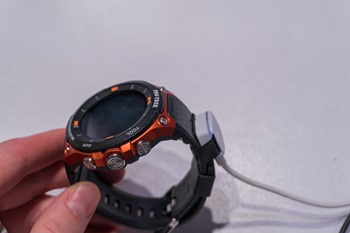
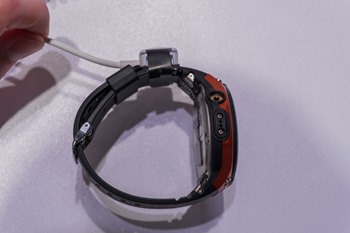
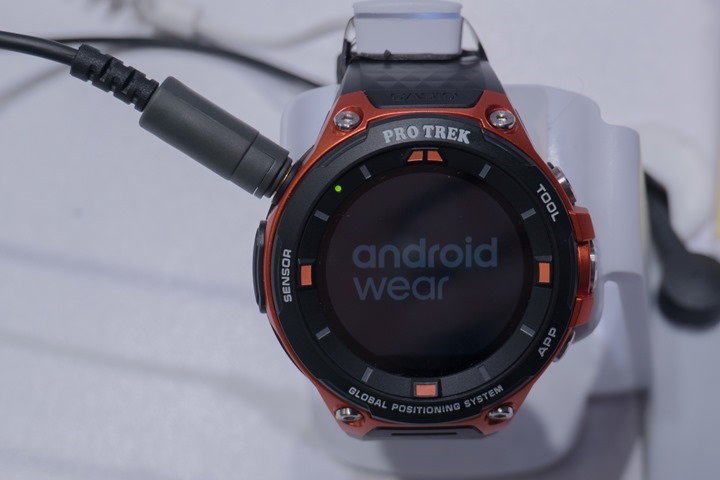

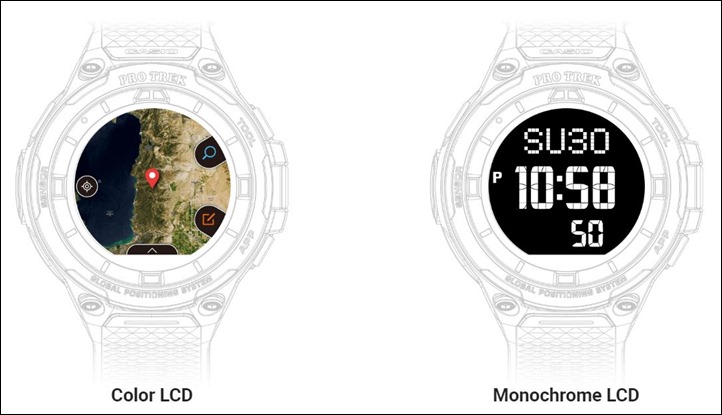
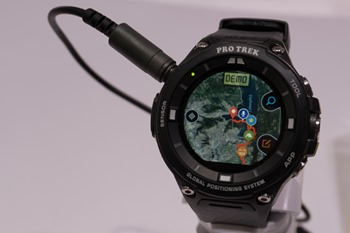
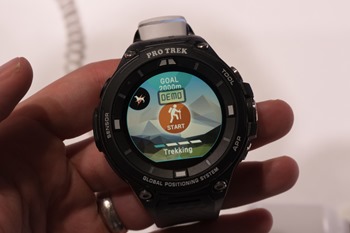
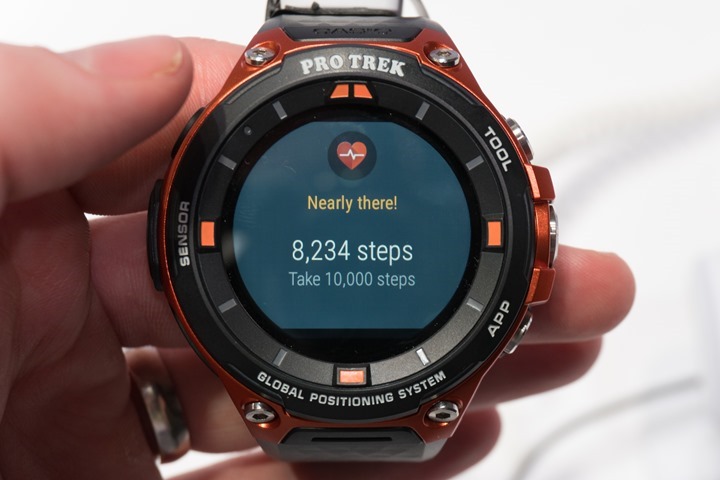
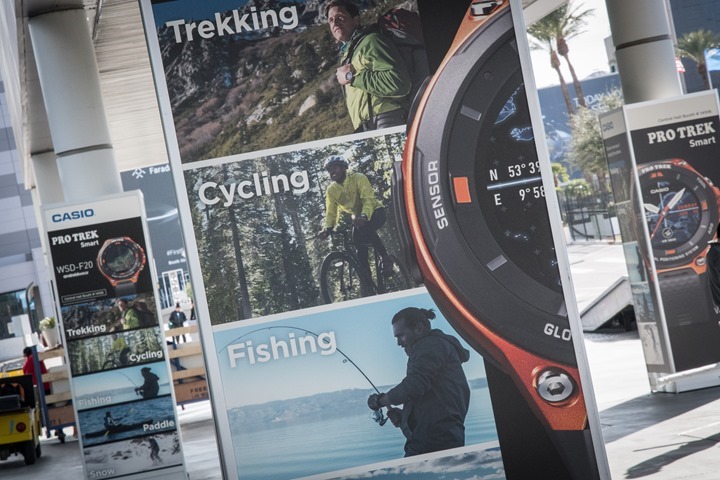





















Agree that Casio is dead wrong about not including the optical sensor. I’m an engineer and my coworkers all know that optical sensors are not as accurate as the chest straps – but EVERYONE I know is willing to give up some accuracy for the convenience and comfort. I also suspect, for less technical users, this opinion is even stronger.
I am an engineer also, and I don’t share your concerns. People value different things. Although I think HR would be cool, I am not willing to give up watch comfort and battery life for it. I know many engineers I work with like me. There are also many engineers I work with who love the apple smart watch or samsung gear. Both of which I would never touch because of abysmal battery life.
So, my point is, in the smart/gps/watch there is such a diverse set of expectations. I think several markets exist, as well as sub markets. Just look at the differences we see in these posts when a new garmin is put out. Everyone wants different things.. As tfk said, what if you are trekking in the cold and want to put your watch outside of your clothes to read the maps? HR is useless at that point and just a battery drain. Now, they can add a feature to disable HR, but as we have seen from Garmin it appears that is still a battery hit regardless of its on or not. Plus, the additional hardware adds cost and complexity.
If casio’s goal here is to hit the “trekking crows”, then I say get those requirements and make them perfect. Maybe that crowd doens’t want HR, I don’t know, I would hope they did some research.
In case anyone wondered…
Yup, that’s heart rate as #1. You can read into it however you’d like to counter, but it’s very similar to research I’ve been a part of as well.
oops, it didn’t upload the pic
Here’s the pic:
link to d25d2506sfb94s.cloudfront.net
If it doesn’t work, it’s here:
link to today.yougov.com
Optical HR suxs. If people would know how inaccurate it is, nobody would buy it.
Couple things, being an engineer doesn’t necessarily make one an expert in every field. So unless you deal specifically with HR monitors, it’s not a great comment qualifier. ;)
Those are interesting study results. The only question I have would be .. is battery life a feature? What good is my wearable for sleep tracking when it dies in the middle of the night or fitness tracking if I then can’t use it on my morning run?
There certainly is a tough problem for companies. I personally opted for a fitness specific watch sans HR (920XT). When I want HR for activities I throw on my HRM. And battery life is so great I can wear the watch all the time.
WRT This post. I’d like to see how rugged the watch is and whether or not it’s something multi-day trekkers would find useful. $500 is steep but not compared to some of the the other equipment those crazy mountain lovers use haha.
My observations on folks monitoring their HR, too many are clueless on what their Max HR actually is. I realize it may be nearly impossible to get your exact max, but so many believe the Gospel for HR is the old 220 minus their age. That may work for about 1/3 of folks, the majority are either doing too little or too much based on that formula computed HR.
interesting chart Adam (hope the LVL is going well…excited!!)
however what if Casio target the 44% that don’t want HR !! It’s still a massive market.
in any case, the chart refers to a sample of FIRST TIME buyers. Maybe Casio’s buyers of lesser watches will upgrade??? I’ve no idea. I did check a casio youtube vid about these watches and it had 17000 views which I thought was surprisingly high – although I confess to rarely frequenting youtube to make a comparison
It’s all about market segmentation as has been alluded to already by others. there are LOTS of sub-markets (segments in marketing-speak not strava-speak)
Such a general statement is wrong. It depends on the sensor and some optical sensors would be more accurate than others, both optical and otherwise.
Depends on the device. I ve got an apple watch and a TomTom runner cardio. HR ont the apple watch is horrible while the runner is almost as good as my wahoo tickr.
Peter – great points. My point in mentioning engineers (who are casual runners, hikers, triathletes) is that we are generally very data driven. But even we are willing to sacrifice accuracy for convenience. My comment was meant to be towards a larger market than perhaps the one Casio is targeting here (as others have noted).
For battery life – the Vivoactive HR is my only data point here. When I do a 5-6 mile run, it takes about a 10-15% hit on battery. So if using continuously (for sleep, steps, etc), on 3-4 GPS enabled workouts (say 45-60 minutes each) a week, I’d say you’d have to charge it 2x per week. I could do a pretty decent day hike with it before charging. My friends (more casual fitness types) with the apple watch have to charge every day.
This past Christmas, there was a great deal on the 920XT as well, but I mainly just run – and I wanted the all-in-one solution. I had been using the Scosche with the FR610.
I’ll have to disagree as well. Accurate or not, most runners that I know don’t use HR monitors, even if their watch already has optical HR. I also see no value in it unless one has a heart condition that needs to be monitored – the number of variables is just too great for the data to mean much performance-wise. Nobody races to see who crosses the finish line with lowest/highest HR numbers. To me, it’s merely a more comfortable gimmick than a HR strap.
Several years of racing including two IMs and various length running races and I’ve never used or had a desire for HR measurements. The HR strap a friend gave me when he upgraded has remained hanging in my workshop. Maybe I’ll try it out some day but not sure what I will get out of it. I have my GPS watch mainly for length, distance, and paces. But HR seems all the rage these days. Along with smart notifications so people can pester you while running. And having every possible metric tracked 24/7, like my coworker who was showing me his sleep metrics on his phone. It was mildly interesting, I guess. Apparently I am not the target market for these devices, lol. What bites is all this stuff they are adding to these watches, most of which I don’t need or want, probably is causing the higher prices we are seeing lately on new devices.
I partially agree with both of you, despite the fact that if I DO WANT to measure my efforts in traning – eventually racing – with a HR device, it MUST be accurate, or all the stuff is totally nonsense.
Of course, a real hardcore racer as Indio22 seems to be, doesn’t need a monitor to know how hard he’s pushing; I guess his experience is fine enough.
Anyway, my experience with optical HR is crappy, and the lack of it on my device would have probably got my watch thinner and more efficient.
I guess I’m having a hard time reconciling the thought that potential purchasers of this watch don’t want any advanced features (i.e. even connecting to a HR strap), they don’t want music, and they don’t want gadgetry of the Garmin/Suunto devices.
Meaning, on one hand I hear folks saying they don’t want optical HR (sure, I can understand that), but everything else doesn’t jive with why someone would pay $500 for this watch? Meaning that everything hiking focused advanced we see is subpar in this watch, and yet the very folks defending it are saying they wouldn’t want those features either way (or any smartwatch features). Said differently: Why spend $500 when you can buy an Ambit2 or even Ambit3 occasionally for $200-250 or so? It’ll last long enough for an Ultra (this won’t), and has far more functionality.
Perplexed…
Perplexed as well.
We went far away, discussing about HR capabilities and accuracy.
The fact is, this is a Casio, and people expects it to be a rugged watch with all trekking-related features + smartwatch oriented ones; probably very few care about HR measuring.
This would fit an otherwise heavy 500 bucks bill; Casio fans will like it anyway (IMHO).
Speaking of rugged, I also don’t understand the definition of rugged.
I hear it tossed around by a lot of folks – and I’m curious, what is rugged?
Is it waterproof (yes, this has that)?
Is it external shell/bezel materials (this is just plastic)?
Is it display materials (this isn’t Sapphire glass)?
Is it simply having ABC functions (yes, this has that)?
Is it that it can be dropped* (there’s no testing that any watch companies note publicly here).
What makes something ‘rugged’?
*Funny side note, to prove how rugged the watch was to me in the booth, the person dropped it from approximately 1″ above the counter, onto the counter. Personally I would have been impressed if they had thrown it against the wall. ;)
I guess most people judge ruggedness as aestethically perceived.
Meaning “it’s rugged because it looks”, but I don’t dare to take a shower with a 500$ watch.
Even less drop it on the trail.
[quote]Meaning “it’s rugged because it looks”, but I don’t dare to take a shower with a 500$ watch.
Even less drop it on the trail.[/quote]
I swim with it in the ocean and even occasionally crash….
My old forerunner 910xt has survived that for almost 5 years. It is not a rugged watch and does not even look roughed. But no i did not wear it as a everyday watch but just for activities. Yes it has battle scars on the casing an even a defect right at the edge of the lcd – but that is to be expected when crashing to the ground at 20+mph
I now gotten a fenix3 hr much cheaper on sale than my previous “activity watch” – I plan to use it as a everyday watch (there replacing a vivifit) and hope that it will also live for 5 years.
It looks more rugged but i don’t think it will take a beating any better than the 910xt did – So i actually consider if i should bring out the old one for high risk activities – at least connect.garmin.com now understand that you can be swithing devices during the day …
My HR response was driven more by the arguably over the top emphasis on HR these days (and as suggested in the review where the overwhelming market is going), compared to the actual value of HR monitoring. One good thing about not having HR monitoring on this watch, is that it will eliminate reams of posts in this thread, from people discussing and kvetching about the accuracy/inaccuracy, tightness and wrist location, various other minutia and functionality/dysfunctionality of the HR monitoring, lol.
Anyway this watch seems like an action/hiking type device, and will sink or swim based on how it does with mapping and other functionalities related to the intended usage. Hard to tell given the functionality was more for display at time of mini-review, and how will ecosystem of apps pan out. I am intrigued by the dual screen thing – monochrome for low battery usage and lit color for other usages. That seems interesting and could be best of both worlds in terms of display.
As a hiker, mapping on a watch also seems interesting, but I would have to try it out in practice to see if my style of hiking would get adequate usage from a small watch based map. Many of my families hikes are exploring (various trails and old mines in Colorado for example) and by intention not always planned out, so I am not clear how valuable watch maps would be. A compass if accurate would be useful though, and hiking Colorado Rockies it is always nice and fun to know reasonably accurate elevation, my kids sure like tracking that during a hike.
I am not put off by the look of this watch as I tend to like more industrial type designs, and also am not sold on the “one watch to rule them all” approach having one watch to wear training, racing and to the office/opera! But it is pricey. If I bash a $500 watch on a rock I would not be happy!
I agree. age – 220 is bxllshxt. They should research better than what they are told. knowledge is the key here.
You can tell it’s a survey of prospective first-time wearable buyers because if they had already had a unit with OHR they wouldn’t be so excited about it. I’m sure it works fine sitting at your desk, but when it actually matters, like when you’re running, it doesn’t work worth crap, and you just end up with a bunch of faulty data. It sucks to finish a workout, and go I wonder what my max heart rate was, oh, according to this OHR that kept losing signal it’s 260bpm, awesome. I’d rather have no data, than bad data that’s going to mess up all my stats (like the Fitness and Fatigue on Strava.)
Hi Tyler. Nice piece but I disagree with your conclusions.
Target market? The clue is in the name “PRO TREKKER”
The ‘USP’s for the Casio are durability, OS and CACHED maps – whether that all will work as expected I have no idea.
Consider: In MANY hiking/trekking scenarios, oHR might require being worn under layers of clothing rendering the maps useless.
You compare to the M600 (I have one and love it). However I’m not sure the M600 would work so well in the middle of a rugged-nowhere. The SPARTAN (I have one) wold work fine there …but no maps. Fenix 5X…Ok fair enough but the Casio is/will be cheaper.
I agree, maybe the price is a tad too high but that is easily changed. The looks? well, yes, not to my taste either but it’s not so bad.
Maps on a watch seems to become a thing.
Any reason why the Garmin Fenix 5X gets such fanfare about maps on the watch and this Casio Pro Trek article treats it like any other feature?
Agree with tfk that the target market may not care about heart rate so much. As a hiker I’d be more interested in battery capacity and durability :-)
I suppose it’s the respective watches target market: in running, or cycling etc as the Fenix 5 is more likely to be used in, maps are not essential but a very nice feature that aren’t found in many watches – or even cycling head units, whereas for the trekking market, trekking GPSes all have maps, so it’s as much a USP as a normal feature.
I think you have to loo a little bit at battery life. That’s where things go askew. Right now they aren’t releasing any official specs. The last time a company held back key/core official specs, it didn’t end well (remember Spartan).
But in this case, we have something to go by – the previous F10 generation from last year. Last year it was a day *without* GPS. This year, it’s an unknown with GPS. The hardware itself looks almost unchanged from last year, and battery advances haven’t really shifted much since then. My bet is with GPS on, they’d be looking at 5-8 hours, or basically, the same as any other Android Watch in a best case scenario. Which substantially less than Garmin/Suunto.
yep, fair comment on the battery.
with the dual-screen I guess they have one potential area for battery improvement that others might struggle more with.
also..
The TomTom Adventurer’s battery saving GPS-hiking mode is an area too for exploration for hikers . I suppose that could then get them well over the 8 hours GPS time that the M600 has. The Adventurer has 20 hours GPS-hiking time (but obviously not androidwear)
Typically application specific design saves energy. Generic designs uses more energy. So even if it stay in mono color with GPS on, my guess is it will still consume more energy than garmin/sunnto/polar activity specific GPS watches. However the Casio seems to be big so will have more gas in the tank.
Any words on if we can use mono display/screen off while in apps and tracking? (like when using strava and tracking)
From all the reviews I am reading I am feeling a bit better about being an Epix owner. I can have offline maps, multi sports functions and great battery life in a nice square display. I think it is a keeper.
It’s got some problems, but the real issue with it isn’t optical HR. HR’s a problem, but they’re not probably marketing this to the first time wearables user. More likely to the person that’s historically worn a Pro Trek or other brand of ABC watch: hikers, campers, trekkers, etc. The same type of person that considers buying an InReach or a personal locator beacon. That’s why that mono screen is intriguing: it extends the battery life. Unfortunately, the existing Pro Trek watches are already great and if you’re going to have an InReach or similar with you anyway…
And if you really want an ABC watch that’s also a GPS device and meets your battery life needs while you’re out in the backcountry, it’s hard to beat an old Suunto Ambit3 or even Ambit2.
Here some more news about the watch:
link to wsd.casio.com
WSD-F10 is reffered twice in the article as GPS watch – this is not correct.
It is correct.
Each time it’s referred to, it’s discussing it as last years Android Wear variant from Casio.
I see what you mean, in one instance it noted it had GPS capabilities, fixed. The other it was discussing the fact that given it didn’t have such capabilities it seems unlikely we’re getting to get better battery life with it vs before.
Why are these posts written in the second person? Who is actually doing the write up?
At the top it lists Tyler Ross as the author. In the “Welcome to CES 2017” post, Ray mentioned that since there’s so much to see, and so little time, he usually brings a friend to help cover more products. This year that friend was Tyler (link to dcrainmaker.com)
Indeed, Tyler was awesome this year. He’s deeply geeky and technical, and definitely understands this stuff.
I read through all his posts prior to publishing, and do add snippets/commentary/etc here and there.
Note that I’ve got a hands-on video of the Casio unit I shot Saturday evening, including a few more snippets I managed to con out of Casio regarding battery life with GPS on (12hrs). Perhaps they were getting lax towards the end of CES, or perhaps they were just making up stuff.
The video is exporting on my Macbook below the seat in front of me on the airplane, but will have to wait to see how good DFW’s WiFi is between flights. Cheers.
Ok, Amazeballs fast wifi in the American club at DFW for the win! Hands-on video uploaded and added to post (or here: link to youtube.com). Enjoy!
As a former 310XT and current 910XT and 920XT owner might have different taste than 1 million Fenix owners, but in my opinion, a round shaped dial on a sporting watch is ridiculously ugly! That is designed to fit the classic watches like Rolex, Omega, Breitling, etc.
Als map functions better fit on Epix then Fenix, Chronos or Casio. It is a pity and shame that Garmin dropped Epix.
Optical HRM is an excellent invention. The issue is, it is installed directly on the backside of the watch, because nobody is wearing it tighted, there is gap between the watch and your skin. This leads to inaccuracy.
For this reason, the Scosche optical HRM seems to be best solution at this field. I ordered one, so I will do a comparism on accurancy with 910XT + Scosche and 920XT + HRM-Tri.
Ohhh, and by the way… I have a Casio device as well, some cheap 40EUR watch. The main purpose was the stopwatch for open water swimming. With a 910XT under the cap I measured the distance, so all the next occasions I used the Casio to measure time for the known distance measured by 910XT.
And I came to a conclusion, that the developer who wrote the software for that Casio has never done any sport and activity at all. The functions and buttons are set up the most unlogical way…
I almost stopped reading after 500 dollars and no HR sensor. That seems like immediate disqualification to me.
Sadly, I did not find any “cool thing” they were able to add because they dropped HR.
If I could compare the looks, it would be to a Land Rover. Not exactly pretty, but has a rugged charm of its own. Having gotten an Fenix3HR for Christmas, I won’t be swapping anytime soon.
About built-in HR sensor, listen to me: I own a pretty good Garmin XT735, which I primarily use to record every training session made.
Whatever the sport (say, running to cycling to XC-skiing or roller ski), there hasn’t been a damn single time the HR reading was even loosely close to the real one (measured by chest strap).
I can tell you this, because I tried several times in comparable sessions, on the very same course, with identical perceived effort, maybe the next following day.
Yes, wrist sensors are very accurate. Only when sitting at my office desk (literally – and proven), or lying on the couch.
Totally useless crap, otherwise.
And I’m not alone; a friend of mine experienced huge differences on a long downhill on his roadbike.
He wasn’t riding the infamous Bolivian Road of Death, of course.
This is my actual example:
Rollerski session, same course, same time and effort; maybe 2 days between sessions.
Chest strap: AVG.115 > MAX 139 (I’m 60, and well trained; possibly the actual HR)
Wrist: AVG.182 > MAX 205
Another one (run easy/mild effort):
Chest strap: AVG.128 > MAX 149
Wrist: AVG.160 > MAX 185
I’d like someone would persuade me optical wrist HR sensor are reliable… (for serious training)
I trust more in some brujo’s from Amazonas wizardry
There’s plenty of folks have good luck with it. In many cases, I’m one of those folks. I’ve published tons of optical HR sensor data (even with the FR735XT) in my posts. And yes, for legit serious training.
Of course, sports will differ. Wrist focused sports have a harder time than those not wrist focused. I also find that many times folks are just ‘doing it wrong’, when it comes to fit/placement/etc… Not blaming folks, but just being honest in what I see. I have one friend that put it right on his wrist bone even though I’ve explained countless times that it doesn’t work there. I keep him around, but only because he makes good food. ;)
Hi Ray,
of course your work is unquestionable, so optical sensors obviously MUST work properly with enough accuracy.
Maybe, as you said, it’s only me; anyway, I think the watch placement is correct, unless I have to tighten the strap so much it would become so uncomfortable I’d wish to cut my arm below the elbow with a chainsaw.
I’m familiar with chest straps since the early Polars I used in my first triathlons in late ’80s, so it doesn’t bother me to wear one.
With the new generations of straps, I enjoy advanced metrics and reliable accuracy every time, so it’s just fine.
Keep up the good work !!
regards,
massimo
I’m pretty happy with optical readings
I havde both the mio link and scosche rhythm+ with the fenix3 hr as the newest addition
On a bike i have had some issues with the mio link on the wrist while the scosche further up the warm works real well.
Outdoors i’ve not that much data compared to Ray but indoor on an kettler ergometer i usually have either a polar belt strap or just optical ear clip for the bikes software and the log the effort on a garmin device with either belt strap or optical. Again the Scosche has proven to be almsot without glitches and the mio link close behind.
Now with the new fenix i’ve had a handfull of indoor rides and so far it tracks very well.
But for swimming i prefer the band of the mio and it has worked very well below a wetsuit – but i’m looking forward to trying out the new garmin swim belt
I as a “huge” casio consumer (5 g-shocks and 4 pro-trecks) and as a fenix 3 user also, this is my take on this watch:
I really don’t care about the HR monitor.. there are better options for a sport watch then a huge casio.. but that display has a huge battery draw.. that thing in the sunlight in full gps drawing a map wont go more than a few hours.. 3 to 4 hours with luck..
I really don’t agree with the reviewer about the “blocky” design , I think it is great, just need more colors, black anyone? there are garmin and suunto for more elegant designs, when I buy a casio I want a beast not something subtle ..
casio just needs to drop this dual display crap and go full transflective like garmin .. casio is going to get killed in the product.
love casio 10x more than garmin, but this year garmin has my money with the f5x (well not quite cause I will buy a casio anyway for sure.. just not this one..)
I personally love the look of this watch, especially compared to the “back to the 1970s” retro space aesthetic Apple watch seems to be chasing. This is a Rogue One watch.
Two things (neither novel additions to this commentary).
1. This is not a “sports” watch for all of you (us, me too) runners, swimmers, cyclists, triathletes, the main readers of DCR. It is a Casio outdoors watch that advances Casio’s usual feature set to include GPS. Anything else is a non-targeted add-on. That is why it does not *need* HR. It will appeal to existing base of Casio users, and it will not appear “ugly” to them. It is not competing against Garmin sports watches or even Suunto Ambit/SSU.
2. Optical HR works fine, but the wrist is a poor general choice for it. For me, I can’t get consistent readings, much less good ones with my Mio or Scosche Rhythm+ on the wrist. I do not have a Garmin FR3HR, but then I have found the Suunto Ambit 2 with the Scosche R+ on my upper arm to be a great combination. So optical works great for me, just not on my wrist and upper arm is more comfortable for me than any chest strap I have tried (many). The other reason that wrist is a poor choice for built-in to watch optical HR is the watch needs to be against your skin. Today I did a snowshow run at -10F and the watch (Suunto Ambit 2) was on my wrist, outside my outer jacket (with two layers of shirts underneath!). The HRM was on my upper left arm, under 3 layers. Works fine! Better than a chest strap would have (been there, done that).
So, Casio may be a good choice for the outdoor *trekking* crowd, but not so much for most readers here, including me (I’m an old, slow trail ultra runner, so long battery life matters :) ).
Thanks for the preview, though. I always enjoy keeping up with the tech out there and this is the place to be for that.
Tyler says in the article: “at least you still have the option to add a Bluetooth Smart heart rate sensor thanks to Android Wear. ”
can someone clarify that for the Casio? does it support HR recording in some form? or not?
Casio’s own apps do not connect to a HR sensor (odd, I know). At least that’s the double-confirmation that both Tyler and I got separately in the booth.
However, Android Wear can do it within a given 3rd party app.
cool. that’s what I thought.
so
1. HR is likely to be a lesser need for the target market BUT can be obtained for those who want it (faff afterwards integrating it all perhaps?). although just to ‘view’ HR I imagine would be easy by switching to the ‘other’ app STRAVA, MAPMywhatever, etc.
and also
2. it seems from the photos to be able to be charged whilst in use. so mitigating some of the (unknown) battery-life concerns
and
3. AMBITs don’t have maps
and finally
4. FWIW : It meets US military standard MIL-STD-810G.
so it seems a reasonable offering to me for a ‘pro trekker’ – albeit of no interest to me whatsoever. If it comes in an all-black version that would even mitigate the ‘looks’.
I’m still going to get a fenix 5x tho
Agree with 1/3/4. Though, having spent a fair bit of time in the realm of #4, I’d focus less on spec and more on real world stuff. Military specs are more guidance than anything. Wikipedia has a particularly great explanation of this for this specific spec: link to en.wikipedia.org
“MIL-STD-810 is a flexible standard that allows users to tailor test methods to fit the application. As a result, a vendor’s claims of “…compliance to MIL-STD-810…” can be misleading. Because no commercial organization or agency certifies compliance, commercial vendors can create the test methods or approaches to fit their product. Suppliers can—and some do—take significant latitude with how they test their products, and how they report the test results. When queried, many manufacturers will admit no testing has actually been done and that the product is only designed/engineered/built-to comply with the standard….”
As for #2 – Charging connector, it wouldn’t be possible to use this unit while charging. I honestly can’t think of a worst charging connector ever on a GPS watch and/or fitness tracker. Tyler wasn’t kidding when he said it was bad. If my 6-month old sneezed in the general direction of this thing, it’d fall off.
That said – I’m generally more curious to see how the interaction works between phone and watch, relative to GPS functions in routing. Things like loading routes from elsewhere, etc… All stuff couldn’t really test or get clear answers on.
#5 you can still storage music (or not?)
Cheers, P
In a way, I wonder why this watch is being reviewed here. It’s obviously not a watch for runners, and although the biking crowd might be interested, the advanced (map) features will be of little use – the screen seems to be too small for a quick glance.
In my opinion, it’s aimed at trekkers who would otherwise use something like the Garmin Oregon 600 series (which I have) , and who drool over having something smaller, wrist-based. I don’t know about you, but heart rate is not of interest to me while hiking – I am not going to hit my max HR anyway, and I don’t use heart rate zones unless I run – and that is what I have my FR 235 for.
Alternatively, I wouldn’t use something like an Ambit 3 for trekking, as waypoint navigation without maps is just silly (for the kind of amateur hiker I am). I want to be able to explore, not be forced to follow a pre-plotted course, and for that I need maps. I need to see where I am and where I could go if I wanted to. My Oregon provides that, including navigation, rerouting, etc. Even when I go running, sometimes I bring either the Oregon, or my phone, to explore areas I’ve never been to (e.g. while on holiday) to find new routes on the go. You can’t do that with an Ambit, and it’s a pain in the behind to do it using my phone or the Oregon (where do you put them while running?), so in those cases, it would even be nice to have this Casio on my wrist. Yes, for that purpose, I would have liked this to be a runner’s watch as well, but they obviously decided that that is not their target audience – so let’s not compare it to those watches, but compare it to handheld GPS-devices!
If it can navigate as well as my Oregon, includes maps cheaper than those Garmin sells, is smaller than my bulky Oregon, sits on my wrist whenever I need it, and is easy to recharge while using it (the Oregon has batteries than can be changed) then I wouldn’t mind getting one. I even like the looks of this thing – although the hard red plastic bits should really have been made of steel. OK, the price is high, but the Oregon is still $400,- as well.
“In a way, I wonder why this watch is being reviewed here. It’s obviously not a watch for runners, and although the biking crowd might be interested, the advanced (map) features will be of little use – the screen seems to be too small for a quick glance.”
I often cover non-running/non-cycling things. Think Fitbit, GoPro, etc…
In this case, a bunch of folks had asked about it via Twitter/e-mail/etc… Also, one doesn’t know it’s not applicable to runners until they’ve gone and checked it out. Chicken and the egg thing. ;)
“As noted above, Casio decided to leave out an optical heart rate sensor. In talking with the company at length, it sounded as though they felt that optical HR data isn’t accurate and therefore users aren’t actually using it. Obviously, I’m not sure I totally agree with this”
I’ve used Polar’s HR sensors for 15 years with very credible results. I got an Android Wear watch with an optical HRM sensor. I turned on the sensor and removed the watch. It kept displaying my pulse. Hm, odd. How does that work? I set the watch down on the table, wondering what would happen if I turned on the HR sensor with the watch removed from the wrist. It turns out the inert table had a pulse. It even varied over time! I contacted the app developer, who couldn’t explain it. I tried it with a different app, same thing. Makes me want to get a compatible chest sensor instead.
Hello Ray,
please consider writing an in-depth review of this Pro Trek watch (link to wsd.casio.com).
WSD-F20 launched at the end of April 2017 to retailers around the (majority of) world and as I can see people are already posting youtube videos and initial impressions. Popular german smartwatch review portal gave it a very good score (link in german language): link to smartwatch-im-praxistest.de
As an outdoor enthusiast I am very interested in topo-maps navigation capabilities and power saving modes this watch offers while trekking/hiking around in great outdoors. I am also aware of the fact that you (i.e.Tyler) somewhat bashed this watch in this pre-release CES2017 review but I would definitely like to know your opinion how it behaves “in the field”.
Also, I find very interesting reading an article of watch developers themselves which you can read here: link to wsd.casio.com
Please write an in-depth review! For all outdoor/trekking/hiking folks sake reading your blog!
Thanks
Correct link to german-language review:
link to smartwatch-im-praxistest.de
you should know that if you buy this watch in another country than your own then you could be in serious trouble. Bought mine in Germany but live in Norway. They told me all I needed to do was download the “casio moment+” app, connect it to the phone and everything will sort itself out. Problem is just a small one.. the app is not available in all countries!!! So now I am stuck with a watch with German language, wrong time, stuck in demo mode and basically.. I can not even tell the time on the thing.. much less anything else.
For a company as big and old as Casio is then this, to me, is just an unbelievable f#$k up and has left me 500 euros short and in a pretty pissed off mood.
I wrote to casio support website but have not received any response yet. I went to Casio retailer here in Norway and they are trying to figure things out for me but to be honest, I am not optimistic. It looks like my only hope is to call/email the store in Germany that sold me the watch and try to get a new one or a refund. That´s a lot of fun when you´re dealing with a country that does not speak good english.
So my verdict.. be VERY careful about buying this watch and take a close good look at it´s competitors watches first.
Hi Ragnar, all you have to do is get an VPN were you can get to your home country play store without any problem to download whatever you need for this watch this will solve your personal problem.
Cheers
Hello.
Is this eatch compatible with Strava?
Antonio, this is a revolutionary watch made especially for outdoors use and on top of that’s an android wear with tons of third party application which you can choose from, it supports strava yes.
Cheers
Ok,
But it’s not a watch for athletes.
Garmin fēnix 5X is the top!
Thank you.
This watch is an outdoor watch without all that extra stuff, it dose what it says outdoors, why do I need a heart rate sensor when I’m on a trekking trail ?Touch screen resolution microphone are useful stuff gamin has a hefty tag price of 699$ while 499$ which is 200 $ more but everyone fancies something, I myself will go for this since I do not need all that extra stuff which gamin offers .
Cheers
Well now you know why this culture reverse engineers everything. What I find comical is that ” oooohhhh don’t touch our watches they are in display mode only”. They do this because they (eastern asia) have a guilty concious of stealing proprietary technology from Finland and US through reverse engineering.
.